(See the original pdf for the figures.)
The importance of Tibetan documents from Dunhuang has long been recognised by European scholars since they were discovered and brought to London and Paris by Sir Aurel Stein (1862-1943) and Paul Pelliot (1878-1945) respectively at the beginning of the twentieth century. However preliminary painstaking and unrewarding work was necessary for them to be fully and systematically used by scholars. In the first volume of her Inventaire (1939, avertissement, p. v), Marcelle Lalou (1890-1967) who carried out this task for the entire Pelliot collection at the Bibliothèque nationale de France writes as follows:
"The manuscripts were brought back just as they were found, in a disorderly state and, more often than not, covered with indescribable filth. When you unpacked a bundle, you discovered a jumble of miscellaneous pieces which, according to your state of mind, you found either repulsive or exciting: disparate pages of every size without any sequential order -- often lacking page numbers or letters indicating which volume they belonged to -- that were ripped and soiled with mud, butter and bird droppings, huge worn-out and wrinkled scrolls, the edges eaten by rodents or chewed-up by ruminants, all in a more or less fragile state, and still smelly after so many years. ... But a patient reader will find these materials as documents of rare value for history, philology, paleography and even for art. One can not overestimate their importance, neither limit the fields of research which would be enriched, if not renewed sometimes, by their study."
Her perspicacious assessment of the importance of these manuscripts from Dunhuang was to prove perfectly correct. The single most eloquent and unequivocal demonstration of their importance for the study of ancient Tibet is without any doubt Documents de Touen-houang relatifs à l'histoire du Tibet by J. Bacot (1877-1965), C.G. Toussint (1869-1938) and F.W. Thomas (1867-1956), Paris, 1940 (published only in 1946 after the Second World War). In this monograph, two texts namely the Old Tibetan Chronicle and Old Tibetan Annals, undisputedly the two most important historical documents discovered at Dunhuang, were transliterated and translated for the first time.
Professor Hisashi Satō, author of Kodai chibetto-shi kenkyū 古代チベット史研究 (A Study on the Ancient History of Tibet) (Kyoto, 1958/59; reprinted in 1977), recalls (personal communication) that it was this publication that enabled him to establish a firm chronology of ancient Tibet, a work which would have been impossible by the use of Chinese materials and later Tibetan texts alone.
For the study of Tibetan civilisation as a whole, R.A. Stein (1911-1999) puts the importance of the Tibetan manuscripts from Dunhuang in the following terms:
"The Tibetan documents from Dunhuang allowed us for the first time to truly reveal the beginning of Tibetan civilisation which remained until then in a dense mist." (Choix, tome I, 1978, preface, p. 5).
However, for many years access to these materials of exceptional value was jealously reserved for the small number of scholars who lived in England or France, or to those exceptionally privileged scholars who could travel to London or Paris. Thanks to an increasing number of publications, monographs and articles, which occasionally had integral or partial facsimile reproductions of the manuscripts, Tibetan documents from Dunhuang became gradually more easily accessible to a greater number of scholars, and their study progressed considerably. Since the 1960s, microfilms have been acquired by a small number of research institutions and libraries outside of England and France. To give just one example, the Toyo Bunko (Oriental Library), Tokyo, became the depository for the microfilm of the Stein Dunhuang collection, both Chinese and Tibetan, kept at the India Office Library and Records (now merged into the British Library) and contributed enormously to the development of "Tonkō-gaku (Dunhuang Studies)" in Japan.
In this respect, the Bibliothèque nationale de France played an important role by publishing in 1978/79 Choix de documents tibétains conservés à la Bibliothèque nationale de France et complété par quelques manuscrits à l'India Office Library (2 tomes) in which a total of 168 of the most important and representative Tibetan manuscripts from Dunhuang (162 from the Pelliot collection and 6 from the Stein collection) were reproduced in facsimile on 640 high quality large (A4) size plates. The 500 copies of this reproduction in facsimile contributed significantly to make Tibetan manuscripts from Dunhuang accessible to a wider circle of academic research.
The new publication entitled Fazang Dunhuang zangwen wenxian 法蔵敦煌蔵文文献 / Tibetan Documents from Dunhuang in the Bibliothèque nationale de France published by Shanghai guji chubanshe上海古籍出版社 which began in 2006 in China (to be completed in ca. 20 volumes) is an epoque-making project. It projects a large size high quality facsimile reproduction of the entire Pelliot Tibetan collection and will be followed by another series which will cover the entire Stein Tibetan collection kept at the British Library. With the completion of these publications, the two most important collections of Tibetan manuscripts from Dunhuang will be accessible to the public for the first time.
Another important project which is almost completed is the digitalisation in colour of all Tibetan documents from Dunhuang kept in London and Paris. In the near future, it will therefore be possible to consult each and every manuscript on the websites of the British Library (a certain number of manuscripts are already on the website of the International Dunhuang Project) and the Bibliothèque nationale de France. With this new ease of access to the entire Stein and Pelliot collections of Tibetan manuscripts from Dunhuang, the study of these manuscripts will enter a radically different new age.
Once this mass of still unexplored materials are easily accessible, the various difficulties peculiar to them, which pioneer scholars have for a century been endeavouring to solve with differing degrees of success, will be fully realised.
First of all, the deciphering of their writing itself is far from being an easy task. In fact, the handwriting of Dunhuang manuscripts has peculiar paleographical features, and is sometimes "diabolical" to use the term employed by Marcelle Lalou (cf. fig. 2 below). The writing style varies from one scribe to another, and even within a single manuscript the style sometimes changes form one passage to another. It is common for the consonant letters nga, ta, da and ra not to be always clearly differentiated and they are often almost impossible to distinguish. Likewise ligatures such as sda and rda look almost alike. In such cases, the context and comparison with parallel passages are the only ways to establish a correct reading. Unfortunately this is not always possible. As the majority of Dunhuang manuscripts are fragmentary, incomplete and unique, it is rather rare that one finds parallel passages in several manuscripts. Further one encounters among the Dunhuang manuscripts numerous syllables and words which are not found in the classical literature and the dictionaries which are known to us. The terminology used in Dunhuang manuscripts is so different from that of classical Tibetan, that even contemporary Tibetan scholars are often of no help in this field. As a result, one is more than often not sure of how to decipher an unknown syllable or word, and in such cases one has no clue to guess its meaning. One is left desperately alone and helpless.
As a pioneer, Marcelle Lalou, who catalogued the entire Pelliot Tibetan manuscript collection, knew this difficult situation better than anyone else. In order to tackle and overcome it, she accumulated, in the course of many years' meticulous cataloguing work, two sets of neatly handwritten files which were certainly her most reliable work tool (They are now deposited at the Société Asiatique of Paris).
The first one consists of transliterations (some partial, but the majority integral) of 167 manuscripts (cf. Imaeda 1998b, p. 78). The facsimile reproductions of a passage of an original manuscript and of its transliteration by Marcelle Lalou show well the difficulty of transliteration and how meticulous Marcelle Lalou was in her work.
 Fig. 1 : Pelliot tibétain 1043 (part)
Fig. 1 : Pelliot tibétain 1043 (part)
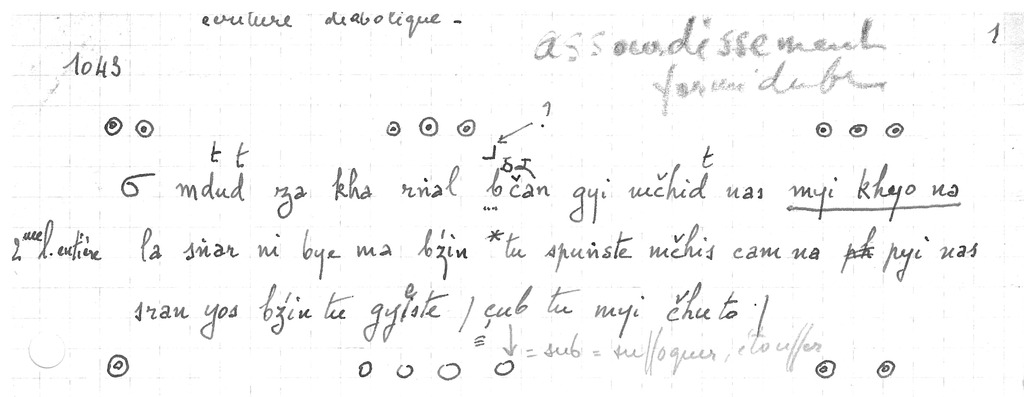 Fig. 2 : Transliteration by Marcelle Lalou
Fig. 2 : Transliteration by Marcelle Lalou
As Marcelle Lalou notes, the handwriting of this manuscript is "diabolical" and a "formidable devoicing" is noticed: the voiced consonant da is completely devoiced and no differentiation is made between da and its devoiced equivalent ta. This manuscript is a fine example of the type of difficulties that one faces in dealing with documents from Dunhuang. Therefore, the transliteration by Marcelle Lalou who had unparalleled experience with them is most precious.
The transliterations by Marcelle Lalou are priceless for a completely different reason. Notwithstanding the preservation measures taken by the Bibliothèque nationale de France and the British Library (initially the British Museum and the India Office Library and Records), certain manuscripts are slowly deteriorating. Pelliot tibétain 1047 is a typical example of this process. This manuscript was integrally reproduced in Choix, tome II with lines numbered 1 through 403. As shown in fig. 3 below, in pl. 335, line 108 ends in the middle with the syllable ngo followed by a shad. After a blank space equivalent to two lines, line 109 starts after a blank equivalent to four or five syllables.
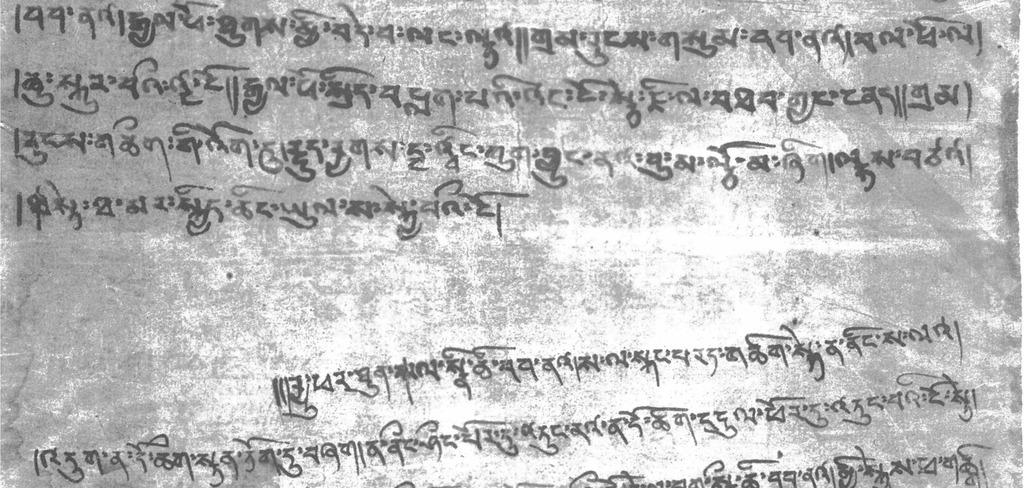 Fig. 3 : Pelliot tibétain 1047 (part) as reproduced in pl. 335 (Choix, II)
Fig. 3 : Pelliot tibétain 1047 (part) as reproduced in pl. 335 (Choix, II)
When the manuscript was photographed in the 1960s, nothing was legible in the blank space between the end of the line 108 and the beginning of the line 109. However in this apparent blank space void of writing, there is in Lalou's transliteration a full sentence written in vermillion ink starting with mo 'di and ending with mi lta'o. This means that when Marcelle Lalou examined the manuscript sometime prior to the1960s, this passage written in vermillion ink was still legible. No photographic record of this passage exists and the transliteration by Marcelle Lalou is its only testimony. We have restituted in the present edition this passage now effaced without any trace (the right half of line 108, full two lines 109 and 110, and the beginning of line 111 which was wrongly numbered 109 in Choix, pl. 335). This is just one example, there are other cases where effaced passages have been restored from the transliteration made by Marcelle Lalou. This amply shows the importance of Macelle Lalou's file of transliterations.
The other set of materials that Marcelle Lalou has left is a file of over a thousand cards of rare syllables and words arranged in Tibetan alphabetical order. For each syllable or word, Lalou transliterates it together with several preceding and following syllables which provide the context in which it appears. In certain cases, Lalou notes personal observations, references to other studies, definitions given in classical Tibetan dictionaries, a tentative definition of the meaning, etc. as shown in the illustration below:
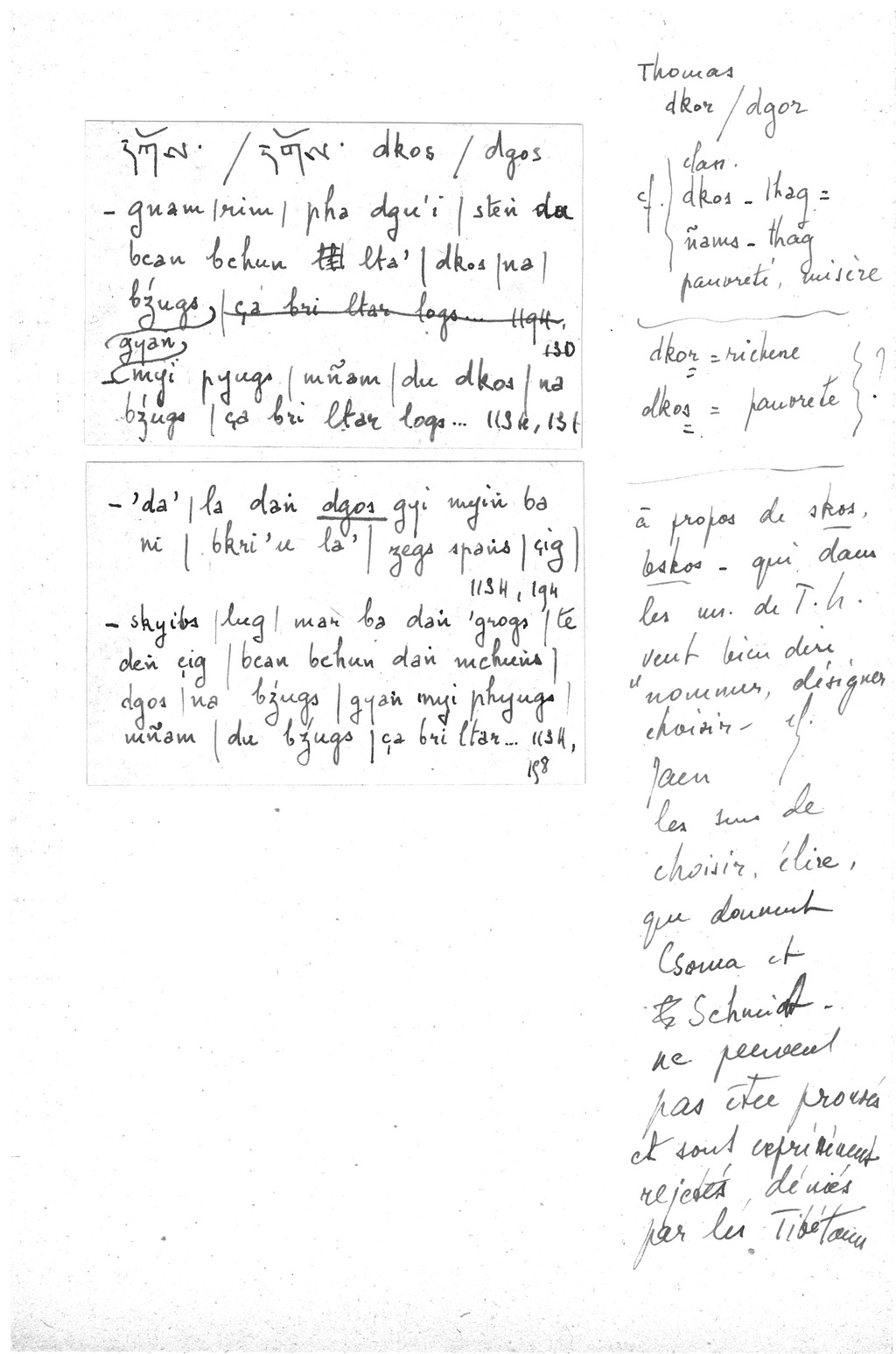 Fig. 4 : Reproduction of Lalou’s cards
Fig. 4 : Reproduction of Lalou’s cards
It is in reference to these cards that R.A. Stein wrote in the preface to Choix (I, p. 7) as follows:
"M. Lalou has accumulated in the course of her reading a voluminous file of rare words, quoting for each word the entire phrase which might be useful to define it. We have a project to publish this vocabulary. However the work will still require much time, because one has to check the reading and the reference of the manuscripts. We also have the intention to complement this vocabulary by notes and remarks that other scholars have made."
As the importance of this vocabulary was evident, it was decided to publish it after the facsimile reproductions of manuscripts Choix I and II. The preparation of this material was entrusted to me in the beginning of 1970s and I typed the cards in four copies which were intended for R.A. Stein, Mme A. Macdonald, Mme A.M. Blondeau and myself for further references, comments and observations. However, for technical and financial reasons, this project never materialized. While typing them one by one, I fully realised the importance of these cards and was convinced that they would be of tremendous help for any researcher who studies Tibetan manuscripts from Dunhuang. At the same time, I was fully aware that numerous and precious as they were, Lalou's cards were not exhaustive listings of rare, unknown or obscure syllables and words among the Dunhuang materials. Marcelle Lalou certainly never intended to make such a listing. Although they are useful and precious as they are, they leave much to be desired as a reference work.
For several years after the project was finally abandoned, I could not help feeling pity for the cards not being made public on the one hand, and on the other hand I continued exploring the possibilities of having a more reliable and exhaustive reference work created. It was during this period that I had the chance of participating in the Tibetan computerization project at Research Institute for Languages and Cultures of Asia and Africa (ILCAA) of Tokyo University of Foreign Studies (TUFS) which was started in the first years of 1970s at the initiative of Prof. Hajime Kitamura (1923-2003). In the1980s, this Tibetan character-based computing system became fully operational with sort facility in Tibetan alphabetical order. To my knowledge, this is one of the first, if not the very first, systems of its kind in the world. Therefore I decided to make use of it for establishing, in collaboration with my colleague Tsuguhito Takeuchi (Kobe City University of Foreign Studies), a critical edition in Tibetan characters of the eleven most important and representative historical documents reproduced in Choix I and II, and for providing an exhaustive KWIC (Key Words In Context) concordance of all the syllables appearing in the texts. The result was published in 1990 by the Bibliothèque nationale de France in the form of printed book entitled Corpus syllabique, volume III of the Choix de documents tibétains series. The utility of this type of work being widely recognized, with the participation of three younger colleagues namely Izumi Hoshi (ILCAA), Yoshimichi Ohara (Okayama University) and Iwao Ishikawa (The Eastern Institute), another 13 texts were subsequently input and Corpus syllabique, volume IV was published in 2001 by the ILCAA in the same format as volume III.
All the participants were fully convinced of the necessity of enlarging the corpus. Therefore, the Old Tibetan Documents Online (OTDO) was formed at the ILCAA with Izumi Hoshi as coordinator and the work continued with two additional members namely Kazushi Iwao (Research Fellow of the Japan Society for the Promotion of Science) and Ai Nishida (Kobe City University of Foreign Studies), both promising students of Tsuguhito Takeuchi. At this stage, through the Grammatological Informatics based on Corpora of Asian Scripts (GICAS) of the ILCAA of which the OTDO became an integral part, was received substantial financial aid from the Japanese Ministry of Research and Education. These funds enabled several members of the project to consult the original materials in Paris and London, which greatly facilitated the deciphering of manuscripts.
At the last stage, Brandon Dotson (School of Oriental and African Studies, University of London) who has been working on Tibetan manuscripts from Dunhuang independently from our project generously agreed to share with us his critical reading of a certain number of manuscripts.
Thus the number of manuscripts transliterated increased (at present 65 in total) and it became evident that further publication in the conventional printed book form had become impractical, if not impossible. Therefore it was decided to publish a cumulative edition of transliterated texts alone in the conventional printed book form, which has its own utility, and leave the KWIC concordance and other tools on the website of the OTDO. At the same time, in order to enable a more critical editing of the materials, it was decided to convert all the data from Tibetan characters into latin letters following the transliteration system designed specifically for the project (for details, cf. pp. XXXI). All the necessary software which resulted from this decision have been assured by Fumihiro Chiba (Tsuklakang Co. Ltd.) who has long experience in computing Tibetan materials. He also designed a new format for the KWIC concordance as shown in fig. 5 and 6, and added new enhanced facilities of search and sort. The present printed edition of texts in transliteration is the first by-product of this newly designed database. The readers of this edition are therefore advised to constantly refer to it for the latest version of the critical edition and for further information and facilities.
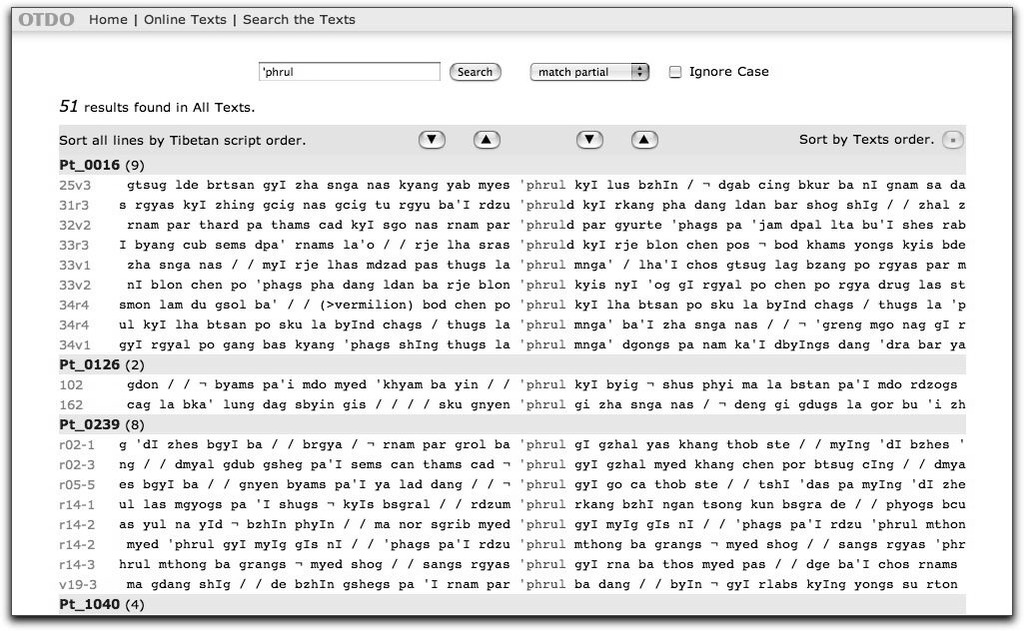 Fig. 5 : Search result (a) : findings shown text by text
Fig. 5 : Search result (a) : findings shown text by text
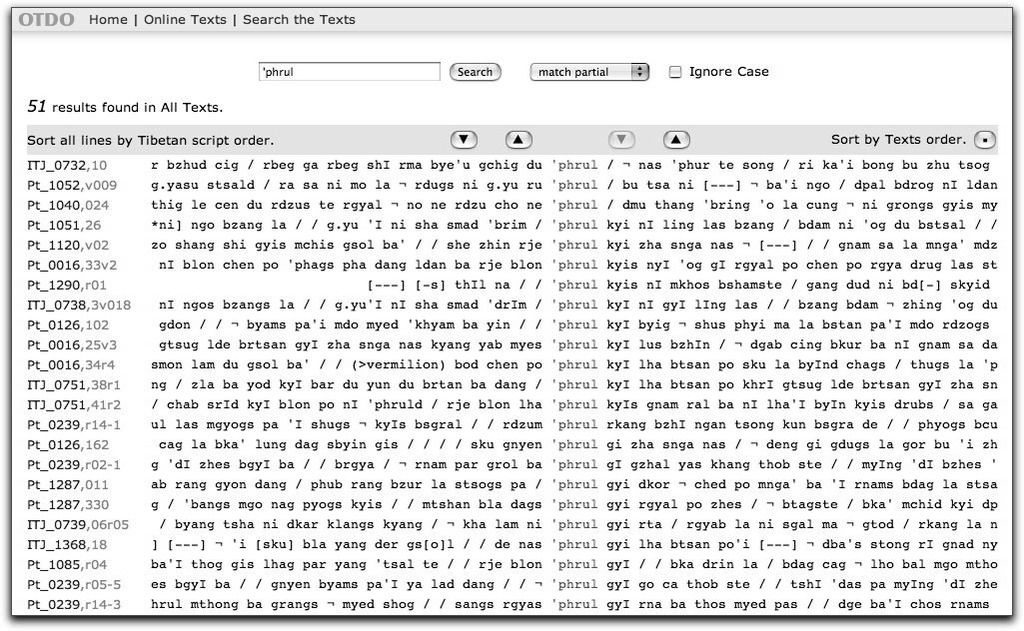 Fig. 6 : Search result (b) : findings shown in Tibetan alphabetical order
Fig. 6 : Search result (b) : findings shown in Tibetan alphabetical order
We are still far behind Marcelle Lalou who transliterated 167 manuscripts, but our KWIC concordance allows us to search exhaustively any syllable and word in all the 65 manuscripts hitherto input, a feature which is impossible with Marcelle Lalou's cards. It is hoped that more manuscripts will be deciphered and added to this database which offers the formidable facility of exhaustive search.
The Old Tibetan Documents Online (OTDO) is an ongoing database project which shall gradually and continuously expand. On the one hand, it will cover more materials of the Imperial and Post-Imperial period (VIIth-Xth centuries): manuscripts from Dunhuang and other Central Asian sites, inscriptions discovered in Tibet and adjacent areas, etc. On the other hand, search facilities like KWIC concordance will be improved and diversified, and various indices for personal names, place names, titles etc. will be made. Maintained and coordinated by the ILCAA, it will be an open forum to which suggestions and contributions from all are most welcome and solicited.
It was exactly 37 years ago in the last days of 1969 that I first laid hands upon several Tibetan manuscripts from Dunhuang in the reading room of the Département des manuscrits orientaux of the Bibliothèque nationale de France, Richelieu. I was excited and fascinated by these over one thousand year old manuscripts but at the same time overwhelmed by their difficulties. With a new powerful tool like the Old Tibetan Documents Online database in hand, I am confident that we are better off for pursuing the decipherment of old Tibetan materials in order to have a better knowledge of ancient Tibetan civilisation.
Directeur de recherche, UMR 8155
Centre National de la Recherche Scientifique